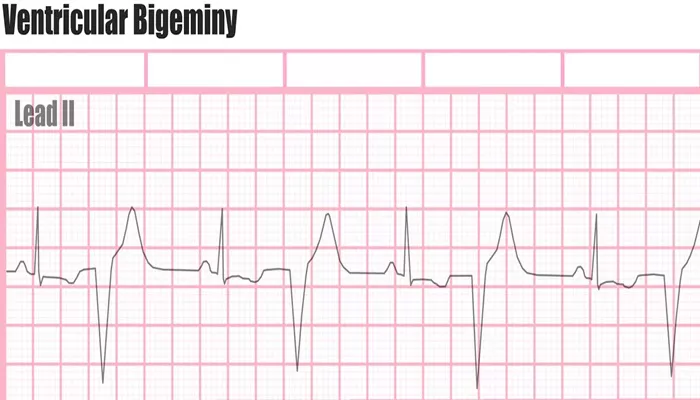Ventricular bigeminy is a type of cardiac arrhythmia where an abnormal heartbeat, called a premature ventricular contraction (PVC), follows every normal heartbeat. This creates a repeating pattern of one normal beat followed by one extra beat. It affects the lower chambers of the heart, the ventricles, and can sometimes cause symptoms or be detected only through heart monitoring tests. Understanding ventricular bigeminy is important for managing its effects and preventing complications.
What Is Ventricular Bigeminy?
Ventricular bigeminy occurs when the heart’s normal rhythm is interrupted by a premature beat originating in the ventricles. After each normal heartbeat, there is a PVC, which is an extra heartbeat that happens too early. This pattern repeats continuously, giving the heart rhythm a “paired” or “bigeminal” appearance. The PVCs can disrupt the heart’s normal pumping action and sometimes cause symptoms or lead to other heart problems.
Causes of Ventricular Bigeminy
Ventricular bigeminy can arise from various factors that affect the heart’s electrical system or overall health:
Heart-related conditions: Coronary artery disease, cardiomyopathy (heart muscle disease), myocardial ischemia (reduced blood flow to the heart), and heart infections can trigger PVCs leading to bigeminy.
Electrolyte imbalances: Abnormal levels of minerals like potassium or magnesium in the blood can disturb heart rhythm.
Stimulants and substances: Excessive caffeine, nicotine, recreational drugs (such as cocaine), and some medications or herbal supplements can provoke PVCs.
Other medical conditions: Thyroid disease and infections elsewhere in the body may contribute to the development of bigeminy.
Stress and anxiety: Emotional stress can increase sympathetic nervous system activity, which may promote PVCs.
Genetic predisposition: A family history of arrhythmias can increase risk.
BAfter a PVC, a compensatory pause occurs, which can create a condition for re-entrant electrical circuits in the ventricles, perpetuating the bigeminal pattern.
Symptoms of Ventricular Bigeminy
Many people with ventricular bigeminy do not experience noticeable symptoms and only discover the condition during routine heart examinations or electrocardiograms (EKGs). When symptoms do occur, they may include:
- Palpitations or feeling of skipped or extra heartbeats
- Fluttering sensation in the chest
- Feeling that the heart is beating too hard or too fast
- Lightheadedness or dizziness (rare)
- Fatigue or shortness of breath if the arrhythmia affects heart function.
Diagnosis
Diagnosis of ventricular bigeminy is primarily made through an electrocardiogram (EKG), which records the heart’s electrical activity and shows the characteristic pattern of alternating normal and premature beats. A healthcare provider may also use a stethoscope to detect irregular heart rhythms and order additional tests such as Holter monitoring (24-hour EKG), echocardiography, or blood tests to identify underlying causes.
Treatment of Ventricular Bigeminy
Treatment depends on the severity of symptoms, the presence of underlying heart disease, and the frequency of PVCs. Many patients with no symptoms and no heart disease do not require treatment but should be monitored regularly.
Lifestyle Modifications
- Avoid stimulants such as caffeine, nicotine, alcohol, and recreational drugs
- Manage stress through relaxation techniques, exercise, meditation, or counseling
- Maintain adequate sleep and a heart-healthy diet
- Monitor and correct electrolyte imbalances.
Medications
When symptoms are present or if ventricular bigeminy is associated with heart disease, medications may be prescribed:
Beta-blockers: These reduce heart rate and sympathetic stimulation, helping to suppress PVCs and alleviate symptoms.
They are often first-line therapy.
Calcium channel blockers: Nondihydropyridine agents like verapamil or diltiazem may be used if beta-blockers are ineffective or not tolerated.
Antiarrhythmic drugs: These are generally avoided unless necessary due to potential side effects.
Possible medication side effects include fatigue, dizziness, gastrointestinal symptoms, and rarely depression or erectile dysfunction with beta-blockers.
Catheter Ablation
For patients with frequent, symptomatic, or refractory ventricular bigeminy, especially when associated with cardiomyopathy or reduced heart function, catheter ablation is a highly effective treatment. This minimally invasive procedure uses radiofrequency energy to destroy the small area of heart tissue causing the abnormal electrical signals.
Success rates exceed 75%, and it can improve heart muscle function if cardiomyopathy is present.
Other Treatments
Electrolyte management: Correcting deficiencies or excesses in potassium or magnesium through diet or supplements can stabilize heart rhythm.
Pacemaker implantation: Rarely, if bigeminy is accompanied by slow heart rates (bradycardia), a pacemaker may be needed to maintain normal rhythm.
Conclusion
Ventricular bigeminy is a common cardiac arrhythmia characterized by an extra premature ventricular beat after each normal heartbeat. It can be caused by heart disease, electrolyte imbalances, stimulants, or other medical conditions.
Symptoms vary from none to palpitations and dizziness. Diagnosis is made by EKG. Treatment ranges from lifestyle changes and medications like beta-blockers to catheter ablation in severe cases. With proper management, most patients have a good prognosis.
Related topics:


